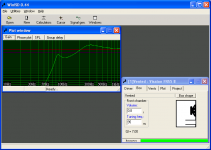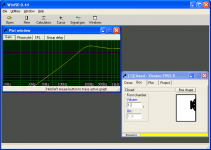I'm building a pair of very small, portable speakers.
The driver units are Visaton FRS 5 8ohm.
http://www.visaton.com/english/artikel/art_257_1_3.html
Frequency and impedance response:
http://www.visaton.com/english/bildgross/257_afrequenzgang.html
Doesn't look bad at all...
But simulated on WinISD, I can't get much better than this.
There's always a big peak at around 300hz, no matter what volume or tuning freq. I choose.
WinISD chooses an 8.5L enclosure (?!), too big, but the peak is there.
Is WinISD fooled by the high(ish) FS of this driver - 250hz?
Or is Visaton telling us the Snow White story?
The driver units are Visaton FRS 5 8ohm.
http://www.visaton.com/english/artikel/art_257_1_3.html
Frequency and impedance response:
http://www.visaton.com/english/bildgross/257_afrequenzgang.html
Doesn't look bad at all...
But simulated on WinISD, I can't get much better than this.

There's always a big peak at around 300hz, no matter what volume or tuning freq. I choose.
WinISD chooses an 8.5L enclosure (?!), too big, but the peak is there.
Is WinISD fooled by the high(ish) FS of this driver - 250hz?
Or is Visaton telling us the Snow White story?
Attachments
joensd said:What a lot of people do with the FRS8 for example (also high Qts) is to take a sealed box (~1l) and use a series cap too flatten out the peak.
Yes, the series cap is an option, but I would loose even more bass...
grrr said:I do not think you can get a flat response with a Qts 1,28 in a bas reflex enclosure. a leak closed box or open baffle may work.
I didn't think about the open baffle option, because I wanted a small speaker.
May give it a try.
What dimentions would you use for such a small driver?
Btw, after running-in for some days, these drivers sound quite good in the midband, and not bad at all in the treble, very extended.
Simulation for a 1,2L (default WinISD calc) sealed box.
The peak follows me around.

Attachments
Bill Fitzpatrick said:Wrong speakers for your intended application.
I'm starting to figure that out...

At 8€ a piece, well...
Gonna try some open baffles, it's easy and I have the MDF...
It's a slow day, you know...
Don't assume that an open baffle has to be large: they don't. They often are, especially with full-range drivers, but it's not an invariable rule. If you haven't looked in the theory section (concepts) here: I suggest you do before proceeding.
http://www.linkwitzlab.com/
Best
Scott
Oh -and WinISD is often quite accurate (not bad at all for freeware), but if you want better modelling software, get Martin King's MathCad worksheets.
http://www.linkwitzlab.com/
Best
Scott
Oh -and WinISD is often quite accurate (not bad at all for freeware), but if you want better modelling software, get Martin King's MathCad worksheets.
That´s what one would think in the first moment.Yes, the series cap is an option, but I would loose even more bass...
BUT a high pass at the right XO-frequency will effectively boost the bass.
Quite "trendy" at the moment in german DIY-magazines:
Sealed subwoofers with series cap(s).
greets
An externally hosted image should be here but it was not working when we last tested it.
All I can come up with at the moment.
Plugged in some numbers in boxsim which is a nice,free and small loudspeaker sim written by a Visaton-forum-member and so includes measured responses from Visaton.
Volume is 1,2L, sealed with 120uF high-pass cap although I´d just throw some different electrolyts at the speaker and listen.
joensd said:An externally hosted image should be here but it was not working when we last tested it.
All I can come up with at the moment.
Plugged in some numbers in boxsim which is a nice,free and small loudspeaker sim written by a Visaton-forum-member and so includes measured responses from Visaton.
Volume is 1,2L, sealed with 120uF high-pass cap although I´d just throw some different electrolyts at the speaker and listen.
That's much better, thanks.
But it rolls-off at 200hz... my point in using the small bass-reflex enclosure was to extend the output a little lower to 80~90hz...
Aham...
I've cut two pieces of 10mm MDF, at 14.5*18cm.
Two round holes, stick the drivers in...
I'm surprized.
No strange effects, very natural sounding, there's even some "bass".
Midband and treble are very good.
Treble is very extended, unlike most fullranges. This is an advantage of such a small driver.
Gets me thinkin' if this driver wouldn't go really well in a two-way speaker, crossed low (like 500hz).
A mix of open-baffle and sealed woofer.

PS: oh, and they image like hell.
I've cut two pieces of 10mm MDF, at 14.5*18cm.
Two round holes, stick the drivers in...
I'm surprized.
No strange effects, very natural sounding, there's even some "bass".
Midband and treble are very good.
Treble is very extended, unlike most fullranges. This is an advantage of such a small driver.
Gets me thinkin' if this driver wouldn't go really well in a two-way speaker, crossed low (like 500hz).
A mix of open-baffle and sealed woofer.

PS: oh, and they image like hell.

- Status
- This old topic is closed. If you want to reopen this topic, contact a moderator using the "Report Post" button.
- Home
- Loudspeakers
- Full Range
- Is WinISD always accurate?

